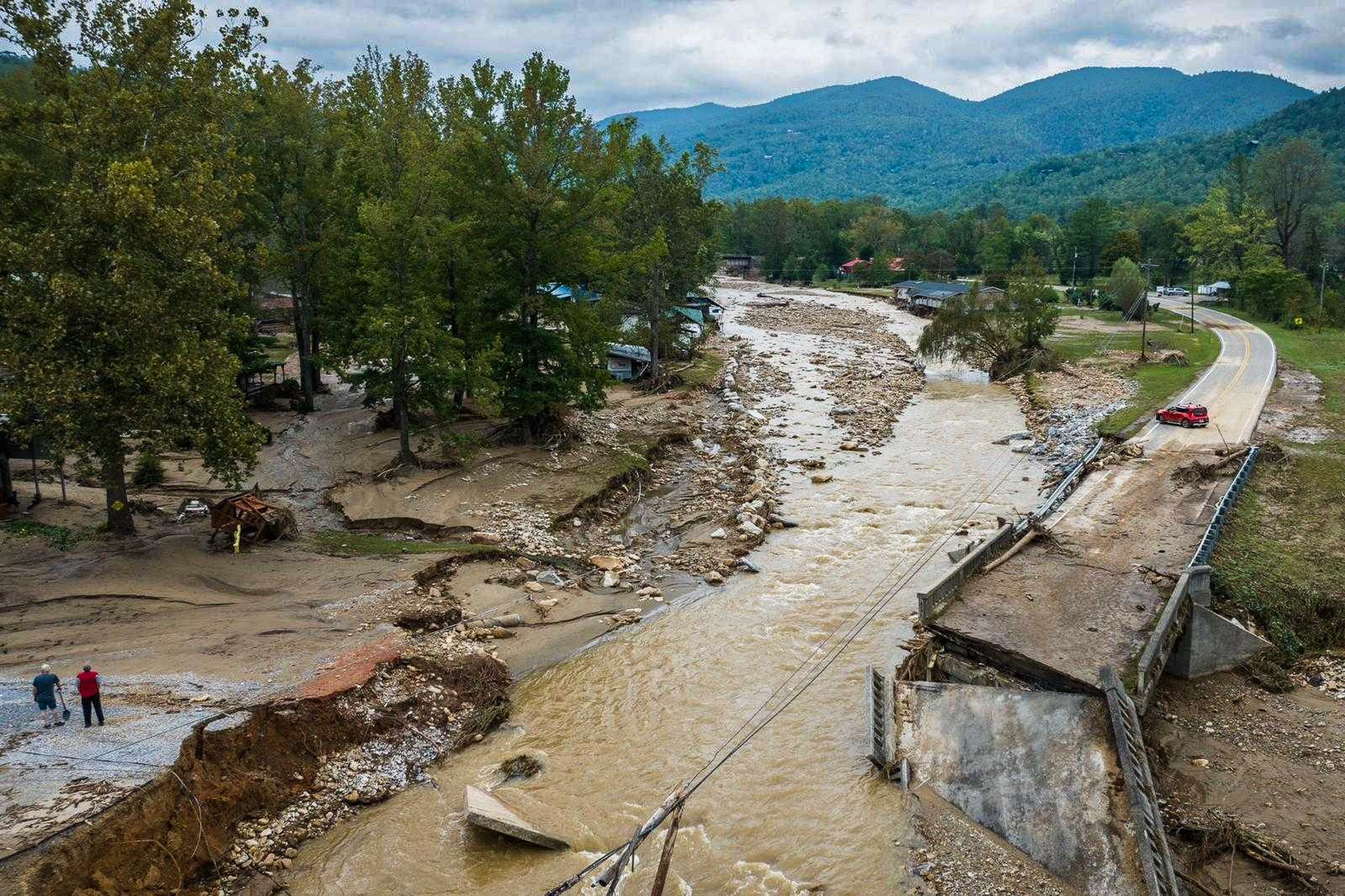A week after Hurricane Helene ripped through the southeastern United States, parts of western North Carolina devastated by the storm are still facing more than 400 road closures. “There are places we can’t get to,” a government official told a local paper. Photos that have made it out of the region show local roads entirely washed away, and others still covered in water.
That this degree of flooding could happen in this part of the country—far inland and long touted by real estate experts as a “climate haven”—demonstrates that the devastating effects of climate change can be felt anywhere and everywhere. Last week, some parts of North Carolina saw more than 2.5 feet of rain in three days. The storm and its floodwaters have killed at least 200 people nationwide, with over 100 still missing in the North Carolina mountains.
A key part of the recovery in North Carolina and elsewhere will be rebuilding the roads, both for supplies to get where they need to go and for a sense of normalcy. In general, states are responsible for building and maintaining their own roads, and the last few years have seen more and more of them grapple with the realities of climate change. “All departments of transportation are looking at more resilient infrastructure in the face of these increased weather events,” says Kevin Marshia, a former Vermont transportation official who is now the director of engineering at the American Association of State Highway and Transportation Officials, a national organization.
Early in the North Carolina disaster response, federal agencies delivered vital food and supplies to residents via “air bridges”—airlifts—and even mules. The Army Corps of Engineers has deployed experts to the region to help with debris removal, water management, and road and bridge inspections. Florida—arguably the national leader in protecting assets from floodwaters—says it has contributed infrastructure damage-assessment teams and temporary bridge materials, which likely include lower-weight steel structures that can be erected without too many tools.
Generally, officials try to get transport back up and running on damaged roads through temporary fixes, including restricting traffic to lanes that can safely handle any vehicles. In the short term, engineers might, for example, replace a washed-away 4-foot culvert (a drain pipe under a road) with whatever size they have premade and close by, knowing they’ll eventually have to go back and install a much deeper, 20-foot version, says Marshia.
The New 50-Year Flood
Longer-term fixes to prepare infrastructure for climate change start with data. Traditionally, engineers use a specific historical flood as a design reference point, says Steve Muench, a civil and environmental engineering professor at the University of Washington who studies transportation infrastructure. A 50-year storm is the sort that can be expected every 50 years; a 100-year storm is a much more intense one that can be expected, yes, every century.
But engineers now realize that more intense weather patterns mean they can’t design simply based on historical records. For every project, transportation engineers need to figure out “how to shift their design procedures from using historical records to ones with better climate prediction,” Muench says.
These more “armored” road projects do typically cost more. But more public officials—though not all public officials—have realized that hardening their roads against intensifying weather will save money in the long run.
Typically, Muench says, the solution isn’t something too complicated: Just build infrastructure higher. But engineers can’t build roads and bridges to survive every disaster, which would lead to expensive, overbuilt projects that would “take generations to finish,” says Muench.
‘Rice Krispie’ Roads
When engineers are rebuilding roads from scratch, they have also started to use different materials to account for the possibility of lots of water arriving really quickly. In the past decade, road builders have increasingly installed more permeable, “spongy” roads.
Pervious concrete, unlike regular concrete, usually excludes sand from the typical “gravel, sand, cement, water” recipe. It also has a lower water-to-cement ratio, which creates a thick paste before it dries. “It’s like caramel popcorn, or a Rice Krispie bar,” says Nara Almeida, who studies the material as an assistant teaching professor in the civil engineering program at the University of Washington Tacoma.
On normal concrete roads, water pools and collects, with the stagnant water eventually damaging its various layers, and especially critical underlying ones, which bear vehicles’ heavy loads. But the increased porosity of pervious concrete allows water to flow through the material more easily, so it can reach and be absorbed into the ground—a nice feature for roads subject to lots of wetness.
Pervious concrete does have its downsides. It’s weaker than normal concrete, which means it’s a better fit for sidewalks, parking lots, and low-traffic streets than interstates that expect a lot of heavy trucks. (Research into reinforcing the material with steel, natural, glass, and synthetic fibers is ongoing.) Its porosity means it’s not a great fit for cold climates, where water can seep in, freeze, and break down the material inside. The concrete also needs regular pressure washing or vacuuming, to “unclog” it from the sort of material often found on the roadway—dust, leaves. Because states sometimes have to switch vendors and processes to use the newer material, the projects might cost them more. But some places have put the material on the shoulders of interstates, says Almeida, which are much less likely to get regular tire poundings.
Ultimately, though, there’s not a lot that can be done when a huge volume of water quickly flows across a roadway or the base of a bridge, which engineers call “scour.” “We’ve all played in the backyard with water and hoses—it’s very damaging,” says Muench, the engineering professor. Part of climate resilience is planning ahead—and staging the quick-fix materials nearby—so communities can rebuild quickly.






